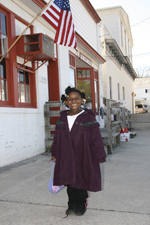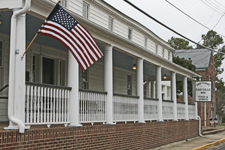Download
in PDF Format
In 1608, Captain John Smith struck out
from Jamestown, accompanied by 32 fellow explorers. Their destination was
the unmapped area now known as the Eastern Shore of Virginia. During their
visit the Englishmen made contact with King Debedeavon, the Laughing
King of the Indians, and a genial relationship was established.
Indeed, Debedeavon became a true
friend to the colonists. During the winter of 1613-1614, as starvation
threatened the Jamestown settlers, the good-humored king sent canoes laden
with food across the Chesapeake. It was about this same time that
Debedeavon granted a tract of land to Thomas Savage, who then established
himself as the first permanent English settler on the Eastern Shore. The
land given to him is today known as Savages Neck and many descendants
of Savage still reside in the area.
|

A
confederate monument is centered on the town's historic Courthouse
Green. |
A historic marker in the colonial-era
town of Eastville memorializes the historic land transfer from Debedeavon
to Savage. But when it comes to history in Eastville, that marker is but
the tip of the iceberg, for this rural hamlet offers a much broader view
of colonial life in America.
Here, in the Circuit Court clerks
office, visitors can view court records dating back to 1628. The office
also houses the oldest continuous court records in America that begin with
an entry in 1632. Among those treasures are a deed marked by the sign of
Indian Chief Ochiwamp, another signed by Daniel Boone, Debedeavons will
designating his daughter as his successor, and the records of court
actions dealing with debts, marriages, indenturement and other aspects of
life.
As the community grew, so too did the
need for a local government and, by 1680, Eastville had been established
as the county seat for Northampton and has remained so ever since.
As such, the town has been the site of
many historic events, including the passage of a court order declaring the
Stamp Act of 1766 unconstitutional and the reading of the Declaration of
Independence from the courthouse steps on Aug. 13, 1776.
That courthouse, built in 1731, stands
today on Eastvilles Courthouse Green. Also on the Green is the old
clerks office, circa 1750, as well as the debtors prison and later
court buildings.
In fact, the Eastville Courthouse
Green is one of the earliest and most complete in Virginia and is listed
as a historic district on both state and federal registers. Today, the
Northampton County government, in conjunction with APVA Preservation
Virginia, maintains the area.
Just south of the Courthouse Green is
the historic Eastville Inn. A colonial coach house, circa 1724, the Inn
has been carefully restored and now offers regional cuisine. A
colonial-style court garden behind the Inn is perfect for an after-dinner
stroll.
In addition to fresh local seafood and
produce, the inn features award-winning Chatham Vineyards Wines.
Those wines are produced at the
Eastville area winery located on historic Chatham Farm. The farm, patented
in 1640, was named after William Pitt, the Earl of Chatham.
A Federal-period house is the backdrop
for the European-style vineyard of Chardonnay, Merlot, Cabernet Franc,
Cabernet Sauvignon and Petit Verdot vines. The winery utilizes both French
and American oak cooperage. Best of all, complimentary tours and tastings
are offered by the Wehner family, owners of the operation.
Visitors to Eastville will also want
to stop by the old county almshouse. Built in 1880, the almshouse has now
been restored and is utilized as the Barrier Islands Center Museum and
Gift Shop.
The center uses the historic 17-acre
setting to house priceless artifacts from the Virginia barrier islands.
Once, those islands were home to Native Americans, watermen, farmers,
outdoorsmen and the Lifesaving Service. While those island communities are
now gone, the museum preserves their stories.
Books on local history are available
at the centers gift shop, as is local art.
|

Chelsea
Mapp strolls down Eastville's Courthouse Road, the main street
running through town. |
More local art can be enjoyed at The
Gallery At Eastville. A design studio located in an original 1908 Sears
house, The Gallery houses the award-winning design team of Mary Miller and
David Bruce Handschur. Here, visitors can marvel at their designs in
glass, wood, fiber, paintings and jewelry.
Just down the street from The Gallery
is Christ Episcopal Church. This church, built in 1828, is part of Hungars
Parish that has provided services on the Eastern Shore since 1623. The
communion service in Christ Church was given in 1741 by John Custis of
nearby Arlington Plantation. Custis was the father-in-law of Martha
Custis, whose second husband was George Washington.
Lt. Gov. Francis Nicholson, one of the
founders of the College of William & Mary, presented the silver alms
basin that can be found at the church.
Another of Eastvilles churches,
Bethel African Methodist Episcopal, also has a rich history. After the
white Methodist Episcopal Church in Philadelphia segregated blacks in
1787, Richard Allen established the African Methodist Episcopal
denomination. It wasnt until 1865, however, that the Eastville church
was founded. Today, the 300 members of the church gather in the third
building to house the congregation, a Gothic-Revival structure erected in
1903.
Visitors wishing to extend their stay
in Eastville have an opportunity to enjoy lodging at the pet- and
horse-friendly Windrush Farm B&B. A circa-1850s country manor,
Windrush is also a horse farm complete with stables and pasture, as well
as lovely English gardens. Boarding facilities are provided for guests who
trailer their own horses, and guided horseback tours along the Chesapeake
Bay shoreline are available for those who do so. Guests also have access
to nearby Smith Beach on the Chesapeake Bay.
PRIME LOCATION FOR OUTDOOR
ENTHUSIASTS
Being located between the Chesapeake Bay and the
Atlantic Ocean offers Eastvilles residents and visitors numerous
opportunities for outdoor adventure. The area is a mecca for anglers, both
onshore and offshore, as well as for those who enjoy boating, canoeing or
kayaking.
The pristine marshlands on both the
bay and seasides of the Eastern Shore peninsula are home to numerous
species of wildlife, drawing nature lovers and photographers from around
the world. This is particularly true each autumn when birding enthusiasts
flock to the area for the fall migration along the Atlantic Flyway.
For those who prefer to travel on two
wheels, the areas bucolic back roads are a cyclists dream.
The growing sport of disc golf is also
popular in the Eastville area, with a course being located at Indiantown
Park. The 55-acre park is now owned by Northampton County. However, from
the late 1600s until around 1835, Indiantown Park was a reservation for
the Native Americans being driven from their land by the settlers.
|

THomes
in Eastville are of both the Victprian and Colonial style. |
Through the centuries, much of the
area has remained largely undisturbed, although some very limited
archeological digs have occurred. What is believed to be a burial mound is
considered a sacred site by the Assateague Indian tribe that occasionally
still holds pow-wows at the park. Here, in November of 1998, the remains
of 10 Native Americans
unearthed during a dig from another area on the Eastern Shore were laid to
rest.
The decline of the Eastern Shore
natives was a relatively quick one. In 1622, the natives from mainland
Virginia planned a massacre. Debedeavon
refused to take part and even warned the settlers of the Shore. Instead of
offering gratitude for his loyalty, Shore settlers used Debedeavons
warning as an impetus for turning on his people. Some were enslaved, some
were killed outright and some were bred out by miscegenation. Sadly, some
died due to epidemics, such as the smallpox epidemic of 1677 that ravaged
the area.
By the time of the Civil War in 1861,
the natives were a memory. Whites had forced them to sell their land in
Indiantown
Park and most of the natives moved north to Maryland.
Today, children play baseball and
soccer on what would have been the oldest Indian reservation in America,
had the natives not been driven away.
No one is driven away from the area
these days; rather, visitors are greeted with open arms, including those
extended by Linda Baylis, executive director of the Northampton County
Chamber of Commerce. The chamber office is located just across the street
from the Eastville Inn. Its a good place to begin a tour of the area
since Baylis and her team of volunteers, known as The Chambermaids,
stand ready to ensure youre on the right path as you take a walk
through Eastville and through history.